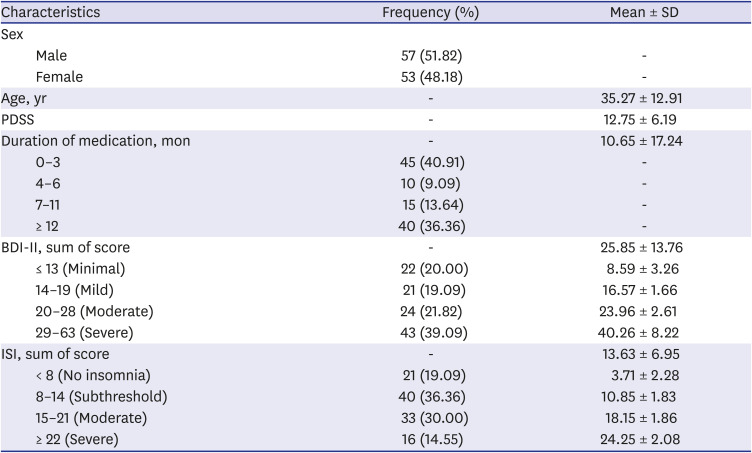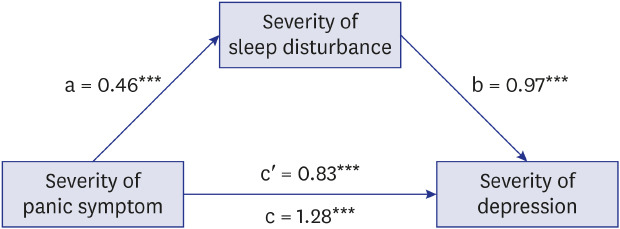1. Wittchen HU, von Zerssen D. The course of treated and untreated depressions and anxiety disorders. A clinico-psychiatric and epidemiological follow-up study. Monogr Gesamtgeb Psychiatr Psychiatry Ser. 1988; 50:1–421. PMID:
3352616.

2. Klerman GL, Weissman MM, Ouellette R, Johnson J, Greenwald S. Panic attacks in the community. Social morbidity and health care utilization. JAMA. 1991; 265(6):742–746. PMID:
1990190.


3. Kessler RC, Chiu WT, Jin R, Ruscio AM, Shear K, Walters EE. The epidemiology of panic attacks, panic disorder, and agoraphobia in the National Comorbidity Survey Replication. Arch Gen Psychiatry. 2006; 63(4):415–424. PMID:
16585471.



4. Clancy J, Noyes R Jr, Hoenk PR, Slymen DJ. Secondary depression in anxiety neurosis. J Nerv Ment Dis. 1978; 166(12):846–850. PMID:
31415.


5. Raskin M, Peeke HV, Dickman W, Pinsker H. Panic and generalized anxiety disorders. Developmental antecedents and precipitants. Arch Gen Psychiatry. 1982; 39(6):687–689. PMID:
7092502.

6. Bowen RC, Kohout J. The relationship between agoraphobia and primary affective disorders. Can Psychiatr Assoc J. 1979; 24(4):317–322. PMID:
466626.


7. Reed V, Wittchen HU. DSM-IV panic attacks and panic disorder in a community sample of adolescents and young adults: how specific are panic attacks? J Psychiatr Res. 1998; 32(6):335–345. PMID:
9844949.


8. Goodwin RD, Hamilton SP. Panic attack as a marker of core psychopathological processes. Psychopathology. 2001; 34(6):278–288. PMID:
11847487.


9. Goodwin RD, Lieb R, Hoefler M, Pfister H, Bittner A, Beesdo K, et al. Panic attack as a risk factor for severe psychopathology. Am J Psychiatry. 2004; 161(12):2207–2214. PMID:
15569891.


10. Pattyn T, Van Den Eede F, Lamers F, Veltman D, Sabbe BG, Penninx BW. Identifying panic disorder subtypes using factor mixture modeling. Depress Anxiety. 2015; 32(7):509–517. PMID:
26014910.


11. Ağargün MY, Kara H. Recurrent sleep panic, insomnia, and suicidal behavior in patients with panic disorder. Compr Psychiatry. 1998; 39(3):149–151. PMID:
9606581.
12. Kryger MH, Roth T, Dement WC. Principles and Practice of Sleep Medicine. 2nd ed. Philadelphia, PA: Saunders;1994.
13. Shear MK, Brown TA, Barlow DH, Money R, Sholomskas DE, Woods SW, et al. Multicenter collaborative panic disorder severity scale. Am J Psychiatry. 1997; 154(11):1571–1575. PMID:
9356566.

14. Shear MK, Rucci P, Williams J, Frank E, Grochocinski V, Vander Bilt J, et al. Reliability and validity of the Panic Disorder Severity Scale: replication and extension. J Psychiatr Res. 2001; 35(5):293–296. PMID:
11591432.


15. Houck PR, Spiegel DA, Shear MK, Rucci P. Reliability of the self-report version of the panic disorder severity scale. Depress Anxiety. 2002; 15(4):183–185. PMID:
12112724.


16. Lee EH, Kim JH, Yu BH. Reliability and validity of the self-report version of the Panic Disorder Severity Scale in Korea. Depress Anxiety. 2009; 26(8):E120–3. PMID:
19373866.

17. Beck AT, Ward CH, Mendelson M, Mock J, Erbaugh J. An inventory for measuring depression. Arch Gen Psychiatry. 1961; 4(6):561–571. PMID:
13688369.


18. Lee EH, Lee SJ, Hwang ST, Hong SH, Kim JH. Reliability and validity of the Beck Depression Inventory-II among Korean adolescents. Psychiatry Investig. 2017; 14(1):30–36.


19. Bastien CH, Vallières A, Morin CM. Validation of the Insomnia Severity Index as an outcome measure for insomnia research. Sleep Med. 2001; 2(4):297–307. PMID:
11438246.


20. Cho YW, Song ML, Morin CM. Validation of a Korean version of the Insomnia Severity Index. J Clin Neurol. 2014; 10(3):210–215. PMID:
25045373.



21. Baron RM, Kenny DA. The moderator-mediator variable distinction in social psychological research: conceptual, strategic, and statistical considerations. J Pers Soc Psychol. 1986; 51(6):1173–1182. PMID:
3806354.


22. Hayes AF. Beyond Baron and Kenny: statistical mediation analysis in the new millennium. Commun Monogr. 2009; 76(4):408–420.

23. Preacher KJ, Hayes AF. SPSS and SAS procedures for estimating indirect effects in simple mediation models. Behav Res Methods Instrum Comput. 2004; 36(4):717–731. PMID:
15641418.


24. Preacher KJ, Rucker DD, Hayes AF. Addressing moderated mediation hypotheses: theory, methods, and prescriptions. Multivariate Behav Res. 2007; 42(1):185–227. PMID:
26821081.


25. Baglioni C, Battagliese G, Feige B, Spiegelhalder K, Nissen C, Voderholzer U, et al. Insomnia as a predictor of depression: a meta-analytic evaluation of longitudinal epidemiological studies. J Affect Disord. 2011; 135(1-3):10–19. PMID:
21300408.


26. Li L, Wu C, Gan Y, Qu X, Lu Z. Insomnia and the risk of depression: a meta-analysis of prospective cohort studies. BMC Psychiatry. 2016; 16(1):375. PMID:
27816065.



27. Clayton PJ. The comorbidity factor: establishing the primary diagnosis in patients with mixed symptoms of anxiety and depression. J Clin Psychiatry. 1990; 51(Suppl):35–39.
28. Merikangas KR, Angst J, Eaton W, Canino G, Rubio-Stipec M, Wacker H, et al. Comorbidity and boundaries of affective disorders with anxiety disorders and substance misuse: results of an international task force. Br J Psychiatry Suppl. 1996; 168(30):58–67.

29. Breier A, Charney DS, Heninger GR. Major depression in patients with agoraphobia and panic disorder. Arch Gen Psychiatry. 1984; 41(12):1129–1135. PMID:
6508503.

30. Buller R, Maier W, Benkert O. Clinical subtypes in panic disorder: their descriptive and prospective validity. J Affect Disord. 1986; 11(2):105–114. PMID:
2948982.


31. Dealy RS, Ishiki DM, Avery DH, Wilson LG, Dunner DL. Secondary depression in anxiety disorders. Compr Psychiatry. 1981; 22(6):612–618. PMID:
7307477.


32. VanValkenburg C, Akiskal HS, Puzantian V, Rosenthal T. Anxious depressions. Clinical, family history, and naturalistic outcome--comparisons with panic and major depressive disorders. J Affect Disord. 1984; 6(1):67–82. PMID:
6231331.

33. Lesser IM, Rubin RT, Pecknold JC, Rifkin A, Swinson RP, Lydiard RB, et al. Secondary depression in panic disorder and agoraphobia. I. Frequency, severity, and response to treatment. Arch Gen Psychiatry. 1988; 45(5):437–443. PMID:
3282480.

34. Clark LA, Watson D. Tripartite model of anxiety and depression: psychometric evidence and taxonomic implications. J Abnorm Psychol. 1991; 100(3):316–336. PMID:
1918611.


35. Fanous A, Gardner CO, Prescott CA, Cancro R, Kendler KS. Neuroticism, major depression and gender: a population-based twin study. Psychol Med. 2002; 32(4):719–728. PMID:
12102386.


36. Hettema JM, Prescott CA, Kendler KS. Genetic and environmental sources of covariation between generalized anxiety disorder and neuroticism. Am J Psychiatry. 2004; 161(9):1581–1587. PMID:
15337647.


37. Brown J, Cohen P, Johnson JG, Smailes EM. Childhood abuse and neglect: specificity of effects on adolescent and young adult depression and suicidality. J Am Acad Child Adolesc Psychiatry. 1999; 38(12):1490–1496. PMID:
10596248.


38. Kessler RC, Stang PE, Wittchen HU, Ustun TB, Roy-Burne PP, Walters EE. Lifetime panic-depression comorbidity in the National Comorbidity Survey. Arch Gen Psychiatry. 1998; 55(9):801–808. PMID:
9736006.


39. Lydiard RB. Coexisting depression and anxiety: special diagnostic and treatment issues. J Clin Psychiatry. 1991; 52(Suppl):48–54.
40. Babson KA, Feldner MT, Trainor CD, Smith RC. An experimental investigation of the effects of acute sleep deprivation on panic-relevant biological challenge responding. Behav Ther. 2009; 40(3):239–250. PMID:
19647525.


41. Barlow DH. Clinical Handbook of Psychological Disorders: a Step-by-Step Treatment Manual. 5th ed. New York, NY: The Guilford Press;2014.
42. Aikins DE, Craske MG. Sleep-based heart period variability in panic disorder with and without nocturnal panic attacks. J Anxiety Disord. 2008; 22(3):453–463. PMID:
17449220.

43. Antony MM, Stein MB. Oxford Handbook of Anxiety and Related Disorders. New York, NY: Oxford University Press;2009.
44. Jackson ML, Sztendur EM, Diamond NT, Byles JE, Bruck D. Sleep difficulties and the development of depression and anxiety: a longitudinal study of young Australian women. Arch Women Ment Health. 2014; 17(3):189–198.

45. Yoo SS, Gujar N, Hu P, Jolesz FA, Walker MP. The human emotional brain without sleep--a prefrontal amygdala disconnect. Curr Biol. 2007; 17(20):R877–8. PMID:
17956744.
46. Novati A, Roman V, Cetin T, Hagewoud R, den Boer JA, Luiten PG, et al. Chronically restricted sleep leads to depression-like changes in neurotransmitter receptor sensitivity and neuroendocrine stress reactivity in rats. Sleep. 2008; 31(11):1579–1585. PMID:
19014078.



47. Balbo M, Leproult R, Van Cauter E. Impact of sleep and its disturbances on hypothalamo-pituitary-adrenal axis activity. Int J Endocrinol. 2010; 2010:759234. PMID:
20628523.

48. Fernandez-Mendoza J, Vgontzas AN. Insomnia and its impact on physical and mental health. Curr Psychiatry Rep. 2013; 15(12):418. PMID:
24189774.



49. Fawcett J, Scheftner WA, Fogg L, Clark DC, Young MA, Hedeker D, et al. Time-related predictors of suicide in major affective disorder. Am J Psychiatry. 1990; 147(9):1189–1194. PMID:
2104515.

50. Johnson J, Weissman MM, Klerman GL. Panic disorder, comorbidity, and suicide attempts. Arch Gen Psychiatry. 1990; 47(9):805–808. PMID:
2393338.


51. Katz C, Yaseen ZS, Mojtabai R, Cohen LJ, Galynker II. Panic as an independent risk factor for suicide attempt in depressive illness: findings from the National Epidemiological Survey on Alcohol and Related Conditions (NESARC). J Clin Psychiatry. 2011; 72(12):1628–1635. PMID:
21457675.

52. King MK, Schmaling KB, Cowley DS, Dunner DL. Suicide attempt history in depressed patients with and without a history of panic attacks. Compr Psychiatry. 1995; 36(1):25–30. PMID:
7705084.









 PDF
PDF Citation
Citation Print
Print





 XML Download
XML Download